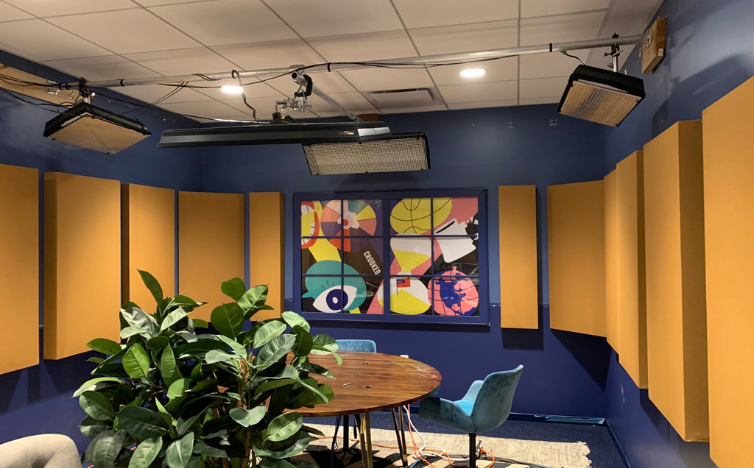As podcasting continues to grow in popularity, creating a professional sound environment has become crucial for podcasters. One of the key elements to achieving high-quality audio is acoustic treatment. Proper acoustic treatment in podcast studios ensures that sound is clear, crisp, and free from unwanted noise, echo, or reverberation. Here’s why acoustic treatment is essential for any podcasting setup.
What Is Acoustic Treatment?
Acoustic treatment refers to the use of specific materials and designs to control sound reflections and absorption within a space. In a podcast studio, acoustic treatments like foam panels, bass traps, and diffusers are used to absorb unwanted noise and reflections, ensuring that only the speaker’s voice is captured without distortion.
Unlike soundproofing, which blocks sound from entering or leaving a room, acoustic treatment optimizes the sound quality within the space.

The Role of Acoustic Treatment in Sound Quality
Acoustic treatment plays a vital role in enhancing the overall sound quality in podcast studios. Without proper treatment, sound waves bounce off walls, ceilings, and floors, creating echoes, reverberations, and uneven sound distribution. This can lead to poor audio quality, making voices sound distant or unclear.
By installing acoustic panels or foam, podcasters can control these sound reflections, creating a well-balanced and professional audio environment. This ensures that the podcast sounds polished and free of distracting background noise, helping to engage listeners and maintain their attention.
Reducing Background Noise and Echo
One of the main benefits of acoustic treatment is its ability to reduce background noise and echo. Even in a relatively quiet environment, sounds from equipment, ventilation systems, or outside noise can affect the recording. Acoustic panels help absorb these unwanted sounds, ensuring that the recording captures only the speaker’s voice.
Echoes, in particular, can be a major issue in podcast studios without treatment. The hard surfaces of walls, floors, and ceilings can cause sound waves to bounce back into the microphone, resulting in an unpleasant echo. Acoustic treatment materials can absorb these sound waves, reducing echo and creating a cleaner recording.
Creating a Professional Audio Environment
For podcasters aiming to grow their audience and monetize their content, professionalism is key. A podcast that sounds amateurish due to poor acoustics can turn off listeners, even if the content is strong. On the other hand, clear and professional audio creates an immersive experience for the audience, making them more likely to return for future episodes.
Acoustic treatment helps to create a controlled environment where podcasters can achieve studio-quality sound. By eliminating distractions like background noise, echoes, and reverberations, acoustic treatment gives podcasters the freedom to focus on delivering their message without technical issues affecting the sound.
Improving Post-Production Efficiency
Acoustic treatment can also save time and effort in post-production. Without proper treatment, podcasters may spend hours trying to remove unwanted noise, balance sound levels, or fix audio inconsistencies. Acoustic treatment helps eliminate these problems from the source, reducing the need for extensive editing and allowing for quicker turnaround times between recording and publishing.
By minimizing the amount of post-production work, podcasters can streamline their workflow and maintain a consistent publishing schedule, which is essential for audience growth.
Choosing the Right Acoustic Treatment for Podcast Studios
When setting up acoustic treatment in a podcast studio, it’s important to choose the right materials based on the studio’s size, layout, and design. For smaller podcast studios, foam panels and bass traps placed strategically around the room can make a significant difference. Diffusers can also be added to scatter sound and create a more natural audio environment.
Understanding the specific needs of your studio will help in selecting the right combination of acoustic treatments to achieve optimal results.
Call us: Contact DeSound Soundproofing Expert in Dubai For Soundproofing: +971 56 231 4204
Conclusion
Acoustic treatment is a fundamental aspect of creating a professional podcast studio. It ensures clear, high-quality sound by reducing unwanted noise, echoes, and reverberations. By investing in acoustic treatment, podcasters can create an immersive listening experience, improve their production process, and build a loyal audience.

